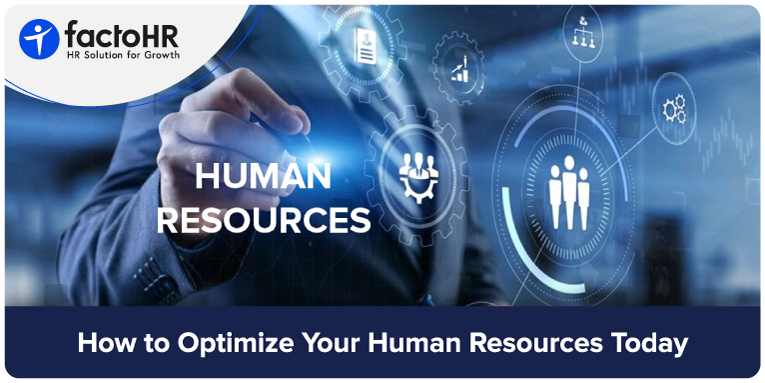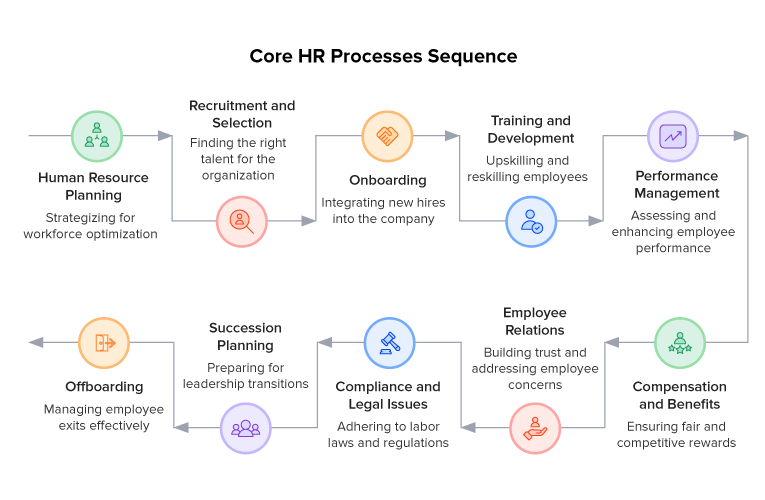10 Core HR Processes Every Business Needs in 2026

Table of Contents
Organizations that optimize their HR processes are more than 2.5 times likely to enhance productivity and employee satisfaction. However, many HR teams still struggle with disorganized spreadsheets, manual onboarding, and compliance gaps.
As an HR Manager or a CHRO, you need more than just human resource policies; you need seamless workflows. Effective HR processes are the foundation of human resource management. When implemented correctly, they reduce friction, ensure compliance, and drive business performance.
This article offers a comprehensive guide to HR processes and their impact on your organization’s human resource management.

What are HR Processes?
HR processes encompass procedures, systems, and strategies that streamline everything from recruitment to onboarding and exit interviews. They are structured and repeatable, forming the operational core of HR. These critical HR functions must ensure consistent, compliant, and scalable execution.
The key HR processes include hiring, onboarding, performance management, workforce planning, salary payments, training, engagement, and offboarding. Disjointed and manual processes introduce inefficiencies that delay decision-making and increase the risk of non-compliance.
Properly structured HR processes mitigate these risks, enabling companies to form teams that consistently perform at a high level.
Why Should HR Leaders Care?
The increasing demand for new talent, driven by operational changes and the introduction of innovations such as artificial intelligence, has led to new challenges. Overcoming these challenges requires an optimal human resource management process.
What are the Key Takeaways?
- HR processes are strategic assets. When optimized, they improve efficiency, engagement, and business agility.
- Automation is no longer optional. Tools like factoHR streamline your workflows and make HR a true business enabler.
- Data fuels better leadership. Integrated processes enable meaningful analytics that support informed decisions.
- It’s all about the employee. A seamless, tech-enabled HRM process delivers a better experience across every touchpoint.

Top 10 Core HR Processes
These foundational HR processes are essential for building a resilient, compliant, and future-ready workforce. Some of these HR processes are:
- Human Resource Planning (HRP)
- Recruitment and Selection
- Onboarding
- Training and Development
- Performance Management
- Compensation and Benefits
- Employee Relations
- Compliance and Legal Issues
- Succession Planning
- Offboarding

1. Human Resource Planning (HRP)
When strategizing for the optimization of HR processes, human resource planning (HRP) becomes a crucial component. So if you’re creating a plan to optimize different HR processes as a part of HRP, you need to:
- Asses existing workforce
- Find skill gaps in skills
- Identify the need for recruitment
- Develop a plan for strategic talent hiring.
However, this is not all. When hiring new talent, consider future skill requirements. So, if you are an HR manager, your human resource planning must include demand forecasting for future talent needs.
2. Recruitment and Selection
Once your HRP is finalized, the next HR process is recruitment. You may face many different recruitment challenges. For example, finding the right talent that suits your organizational needs can be a complex process. You may need talented developers who can build software rapidly, but finding the ones that align with the programming language and frameworks you use is difficult. You must consider the future needs of the organization.
3. Onboarding
After hiring the right talent, the next step is onboarding. This is an HR process that onboards newly hired employees and introduces them to your existing systems. It is a gradual process and requires proper documentation to ensure a smoother transition of the talent you hire.
4. Training and Development
Recruiting top talent is just the beginning — the real challenge lies in upskilling and reskilling existing talent. That’s where training and development come in. This HR process ensures continuous learning and helps improve your organization’s overall productivity.
5. Performance Management
As a CHRO or HR manager, you must continuously assess and enhance employee performance. Employee performance evaluation is a continuous process that requires proper feedback systems to gather valuable insights.
6. Compensation and Benefits
Fair and competitive compensation is more than just salary. It allows you to maintain employee satisfaction and ensure better retention.
To optimize this HR process:
- Benchmark compensation against industry standards
- Offer flexible benefits that meet diverse needs
- Communicate rewards clearly to employees
- Review and update packages annually
7. Employee Relations
Employee relations are not just about providing proper benefits or salary. They are more about gaining trust. You need to connect with employees, understand their pain points, and try to solve them. This will help you reduce the gap between what you offer and what employees expect.
8. Compliance and Legal Issues
Every HR manager must avoid any type of legal issue because, as an organization, your firm can’t ignore the local labor laws. Ensuring compliance is a significant process of human resource management. You must implement measures to comply with regulatory requirements.
9. Succession Planning
Leadership changes can disrupt operations if you are not prepared for them. Succession planning is the strategic process of identifying and grooming future leaders from within.
10. Offboarding
Employee exit is as important as their entry. Offboarding is the structured process of managing resignations, retirements, or terminations. When handled well, offboarding protects your organization’s data, strengthens employer branding, and may even create future advocates for your business.

How does the HR Process Work?
The HR process is a suite of activities that manage every aspect of human resource management. It starts with HRP, which organizations use to identify workforce gaps. Based on gaps, you need to determine the recruitment needs. As per these needs, select the talent.
Next, you onboard, train, and evaluate their performance. While evaluation is continuous, you must also manage their data, benefits and compensation. All HR processes, including an employee’s exit, are covered.
What are the Benefits of HR Process Automation?
Here are the key benefits of HR process automation:
1. Increased Focus on Strategic Initiatives
By automating administrative tasks such as payroll processing and leave management, HR teams can redirect their efforts toward high-impact activities. This enables greater focus on organizational culture, leadership development, and initiatives that enhance employee well-being.
2. Enhanced Accuracy and Employee Confidence
Automation minimizes human error by ensuring consistent documentation, accurate record-keeping, and timely execution of HR processes. This not only fosters employee trust but also supports ongoing compliance with labor regulations.
3. Significant Cost Efficiencies
Manual workflows often result in hidden costs, ranging from document handling to error correction. Automation streamlines operations, reduces administrative overhead, and enhances team productivity, leading to long-term financial savings.
4. Improved Employee Experience
Modern employees expect seamless digital interactions. Automated HRMS software provide intuitive self-service portals, mobile accessibility, and faster response times, contributing to a more positive and user-friendly employee experience.
5. Access to Real-Time Data for Informed Decision-Making
HR professionals manage extensive employee data. Automation tools offer dynamic dashboards and real-time reporting, providing critical insights into workforce metrics such as headcount, attrition, and performance trends, which enables proactive and data-driven decision-making.
6. Proactive Workforce Planning
With real-time visibility into workforce data and future needs, HR teams can anticipate talent gaps, align hiring with strategic goals, and support sustainable business growth through well-informed workforce planning.

What are HR Process Challenges?
Here are the key challenges that you may face while managing HR processes:
1. Disconnected Tools and Workflows
Organizations often utilize disparate systems for payroll, recruitment, and performance management. The lack of integration between these tools leads to operational silos, inefficiencies, and communication gaps.
2. Manual Errors and Inconsistent Data
Manual processes are prone to errors, including misspelled names, incorrect start dates, and incomplete documentation. As organizations scale, these risks compound, potentially leading to compliance issues and reduced data reliability.
3. Wasted Budget
Without comprehensive visibility into HR operations, organizations may overspend on redundant software, underutilize licenses, or employ inefficient hiring practices, resulting in avoidable financial waste.
4. Poor Employee Experience
Delays in approvals, ambiguous policies, and the absence of structured feedback mechanisms contribute to a negative employee experience. Over time, this can lead to decreased engagement and increased turnover.
5. Lack of Actionable Insights
When data is siloed, strategic decision-making becomes challenging. HR leaders require real-time reporting capabilities to effectively plan initiatives related to recruitment, engagement, and retention. Access to up-to-date compliance guidelines is crucial for meeting regulatory standards and ensuring organizational accountability.
6. Reactive Workforce Planning
A lack of proactive planning leads to a reactionary approach to hiring, where recruitment occurs only in response to immediate needs. This short-term mindset can hinder growth and create talent shortages that disrupt business operations.

Best Practices for Managing HR Processes
For a business to succeed and support its goals, effectively managing HR processes is necessary. Here are a few critical guidelines each HR leader should use:
1. Apply Integrated Systems for HR
When your HR functions are combined and centralized with software, you can conduct them all much more smoothly, with enhanced accuracy and speed.
See how factoHR offers a simple solution for all your HR tasks using automation.
2. Standardize Procedures
It is essential to practice standardization and compliance on a regular basis. Establish consistent systems and processes to facilitate compliance and minimize errors.
3. Regularly Evaluate the Objectives
HR plans must be updated as the business changes. Plan to review your operation at regular intervals, align your processes with company goals, and make improvements if needed.
4. Help Workers Expand Their Skills and Knowledge
Your company’s success depends on your people. Offer training sessions to your staff to help keep them engaged, motivated, and ensure they remain with your company.
Conclusion
Improving HR processes enhances a company’s operations and ensures compliance with relevant policies. Modern HR platforms, such as factoHR, provide additional tools that enable you to enhance employee satisfaction. Such solutions help reduce the time spent on administrative tasks, allowing you to focus more on human resource policy development. For a company to adapt to changes and achieve success, a robust human resources (HR) system is essential.
Grow your business with factoHR today
Focus on the significant decision-making tasks, transfer all your common repetitive HR tasks to factoHR and see the things falling into their place.

© 2025 Copyright factoHR


